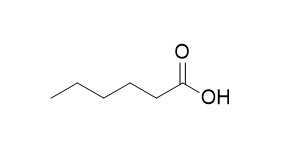Hexanoic acid
Hexanoic acid is a potent natural priming agent of proven efficiency in a wide range of host plants and pathogens. It can early activate broad-spectrum defenses by inducing callose deposition and the salicylic acid (SA) and jasmonic acid (JA) pathways。
Inquire / Order:
manager@chemfaces.com
Technical Inquiries:
service@chemfaces.com
Tel:
+86-27-84237783
Fax:
+86-27-84254680
Address:
1 Building, No. 83, CheCheng Rd., Wuhan Economic and Technological Development Zone, Wuhan, Hubei 430056, PRC
Providing storage is as stated on the product vial and the vial is kept tightly sealed, the product can be stored for up to
24 months(2-8C).
Wherever possible, you should prepare and use solutions on the same day. However, if you need to make up stock solutions in advance, we recommend that you store the solution as aliquots in tightly sealed vials at -20C. Generally, these will be useable for up to two weeks. Before use, and prior to opening the vial we recommend that you allow your product to equilibrate to room temperature for at least 1 hour.
Need more advice on solubility, usage and handling? Please email to: service@chemfaces.com
The packaging of the product may have turned upside down during transportation, resulting in the natural compounds adhering to the neck or cap of the vial. take the vial out of its packaging and gently shake to let the compounds fall to the bottom of the vial. for liquid products, centrifuge at 200-500 RPM to gather the liquid at the bottom of the vial. try to avoid loss or contamination during handling.
Pathogens.2018, 7(3):E62
Sci Rep. 2018, 1-9
Molecules.2022, 27(7):2093.
Toxicol Appl Pharmacol.2022, 434:115815.
Antibiotics (Basel).2024, 14(1):8.
Nat Chem Biol.2018, 14(8):760-763
Nutr Res Pract.2020, 14(3):203-217.
Nutrients.2023, 15(12):2810.
J of L. Chroma.&Related Tech2017, 252-258
Chem Pharm Bull (Tokyo).2019, 67(11):1242-1247
Related and Featured Products
Frontiers in Plant ence, 2014, 5(488):488.
Priming of plant resistance by natural compounds. Hexanoic acid as a model.[Pubmed:
25324848]
Some alternative control strategies of currently emerging plant diseases are based on the use of resistance inducers. This review highlights the recent advances made in the characterization of natural compounds that induce resistance by a priming mechanism. These include vitamins, chitosans, oligogalacturonides, volatile organic compounds, azelaic and pipecolic acid, among others. Overall, other than providing novel disease control strategies that meet environmental regulations, natural priming agents are valuable tools to help unravel the complex mechanisms underlying the induced resistance (IR) phenomenon.
METHODS AND RESULTS:
The data presented in this review reflect the novel contributions made from studying these natural plant inducers, with special emphasis placed on Hexanoic acid (Hx), proposed herein as a model tool for this research field. Hx is a potent natural priming agent of proven efficiency in a wide range of host plants and pathogens. It can early activate broad-spectrum defenses by inducing callose deposition and the salicylic acid (SA) and jasmonic acid (JA) pathways. Later it can prime pathogen-specific responses according to the pathogen’s lifestyle. Interestingly, Hx primes redox-related genes to produce an anti-oxidant protective effect, which might be critical for limiting the infection of necrotrophs.
CONCLUSIONS:
Our Hx-IR findings also strongly suggest that it is an attractive tool for the molecular characterization of the plant alarmed state, with the added advantage of it being a natural compound.
J Plant Physiol,2011 Mar 1;168(4):359-66.
Priming for JA-dependent defenses using hexanoic acid is an effective mechanism to protect Arabidopsis against B. cinerea.[Pubmed:
20950893]
METHODS AND RESULTS:
Soil drench treatments with Hexanoic acid can effectively protect Arabidopsis plants against Botrytis cinerea through a mechanism based on a stronger and faster accumulation of JA-dependent defenses. Plants impaired in ethylene, salicylic acid, abscisic acid or glutathion pathways showed intact protection by Hexanoic acid upon B. cinerea infection. Accordingly, no significant changes in the SA marker gene PR-1 in either the SA or ABA hormone balance were observed in the infected and treated plants. In contrast, the JA signaling pathway showed dramatic changes after Hexanoic acid treatment, mainly when the pathogen was present. The impaired JA mutants, jin1-2 and jar1, were unable to display Hexanoic acid priming against the necrotroph. In addition, Hexanoic acid-treated plants infected with B. cinerea showed priming in the expression of the PDF1.2, PR-4 and VSP1 genes implicated in the JA pathways. Moreover, JA and OPDA levels were primed at early stages by Hexanoic acid. Treatments also stimulated increased callose accumulation in response to the pathogen. Although callose accumulation has proved an effective IR mechanism against B. cinerea, it is apparently not essential to express Hexanoic acid-induced resistance (HxAc-IR) because the mutant pmr4.1 (callose synthesis defective mutant) is protected by treatment.
We recently described how Hexanoic acid treatments can protect tomato plants against B. cinerea by stimulating ABA-dependent callose deposition and by priming OPDA and JA-Ile production.
CONCLUSIONS:
We clearly demonstrate here that Hx-IR is a dependent plant species, since this acid protects Arabidopsis plants against the same necrotroph by priming JA-dependent defenses without enhancing callose accumulation.



